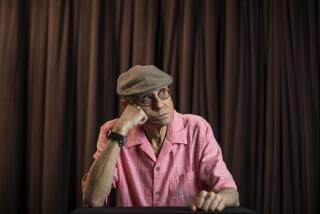Haunted by his lost friend, his demons
- Share via
Six Easy Pieces
Easy Rawlins Stories
Walter Mosley
Atria Books: 278 pp., $24
*
Over the course of seven novels in 10 years, Walter Mosley has created one of the most indelible portraits of black male heroism in American fiction. His midcentury protagonist, the janitor-cum-sleuth Easy Rawlins, is a philosophical knight-errant as likely to read Ayn Rand as use his fists to settle a score in L.A.’s back alleys and courtyard apartments. Over the years, Easy’s sense of mission has taken him from the seedy bars of post-World War II Watts to the mansions of Beverly Hills, where he acts as a mediator between white and black worlds by brokering a kind of moral justice for those who get no such satisfaction from the law.
Through most of the novels in the series, Easy’s sidekick and “barometer for evil” was Raymond “Mouse” Alexander, a sharp-dressing, gray-eyed purveyor of mayhem as crazy as he was attractive to the ladies. Yet, as all who follow the series will lament, Mouse was tragically killed in “A Little Yellow Dog” in one of those back alleys the two men frequented, trying to help his friend Easy out of a jam. When last seen in late 1963, Mouse was being spirited away from a hospital in the arms of his wife, EttaMae, with all the drama accorded a fallen Norse god being borne to some undisclosed Valhalla.
While Mosley’s seventh novel, “Bad Boy Brawly Brown,” showed Easy haunted by his best friend’s death even as he pursues a case, “Six,” which takes place in early 1964, reveals the knight-errant’s near-obsessive drive to determine, once and for all, if Mouse is really dead or, as a mysterious caller suggests in “Smoke,” the first story in the collection, alive and in hiding, perhaps in Northern California, perhaps closer to home.
Easy’s quest takes him on various meandering investigations that draw him closer to an answer about Mouse. It also illustrates how much things have changed while remaining the same for people of color in the 1960s. Yes, African princes dream of freeing their people from colonial regimes, and Easy encounters for the first time “a man, black or white, holding a professional office ... giv[ing] me the benefit of the doubt.”
But it is also a world in which a young black man is targeted for murder for running away with a rich white girl and an innocent black woman is fired by her white employer in retaliation after Easy slaps him senseless.
Easy’s acceptance of the dichotomy between the racially black and white worlds he’s operated between his entire adult life and the increasingly gray world in which he mourns Mouse gives the collection an almost dreamlike quality that makes it difficult to know what’s (or who’s) real.
Part of the difficulty may lie in the fact that most of the stories in “Six” were originally published separately in repackaged paperback editions of the novels. While it may have been a clever marketing ploy for the paperbacks, lack of judicious editing of the collected stories has created a barrier to engaging with “Six,” particularly during repeated review of Easy’s family, friendship and career connections.
But by the time Easy’s live-in girlfriend, flight attendant Bonnie Shay, forces Easy to deal with issues of fidelity and trust in “Lavender,” a story in which EttaMae also reappears with a case that offers Easy yearned-for absolution for his role in her husband’s death, “Six” kicks in and delivers the deceptively simple emotions and acute observations about life, race and relationships that characterize the best of Mosley’s writing.
Bedeviled by both Bonnie’s possible infidelity and Mouse’s fate, Easy is forced throughout “Six” to face some of his own demons -- his insecurity about being street smart rather than book educated, his disturbing willingness to adopt Mouse’s violent tactics, the continued attraction of street life over his 9-to-5 job as supervising custodian at the aptly named Truth Junior High School. In solving these fundamental mysteries of the human heart, Mosley not only offers a hint of further adventures for the middle-aged Easy but again shows us why he is among the best writers of any genre.
More to Read
Sign up for our Book Club newsletter
Get the latest news, events and more from the Los Angeles Times Book Club, and help us get L.A. reading and talking.
You may occasionally receive promotional content from the Los Angeles Times.










